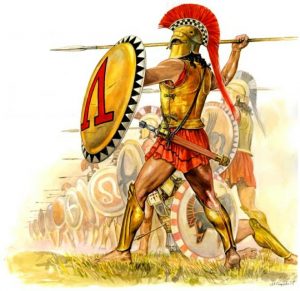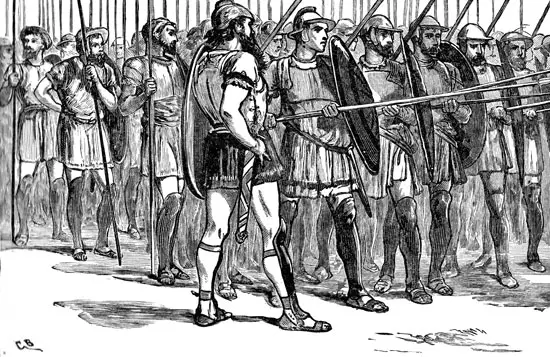Ancient Greek Hoplites: Hoplite warfare was in decline; there were three major battles in the Peloponnesian War, none out of which proved to be decisive. Instead, there was an increased reliance on navies, skirmishers, mercenaries, city walls, siege engines, and non-set piece tactics.

Ancient Greek Hoplites: Sword
These reforms made wars of slow destruction possible and greatly increased the number of casualties. In the Persian war, hoplites faced large numbers of skirmishers and missile-armed troops, and such troops like for e.g., the Peltasts became much more commonly used by the Greeks during the Peloponnesian War.
As a result, Greek Hoplites began wearing less armor, carrying shorter swords, and in general adapting for greater mobility; thereby leading to the development of the Ekdromoi light hoplite.
Hoplite Phalanx
The hoplite phalanx belongs to the Archaic and Classical periods in Greece which was a formation in which the hoplites would line up in ranks in close order. The Greek Hoplites would lock their shields together, and the first few ranks of soldiers would project their spears out over the first rank of shields.

Hoplite Shield
The phalanx, therefore, presented a shield wall and a mass of spear pointing towards the enemy thereby making frontal assaults much more difficult. It also allowed a higher proportion of the soldiers to be actively engaged in combat at a given time rather than limiting them to only those in the front rank.
When advancing towards an enemy, the phalanx would start running sufficiently fast enough to create momentum but not too much as to lose cohesion. The opposing sides would collide viciously, possibly terrifying many of the hoplites of the front row.

The battle would then rely on the bravery of the men in the front line; whilst those in the rear maintained forward pressure on the front ranks with their shields. When in combat, the whole formation would consistently press forward trying to break the enemy formation.
As time passed by, more and more sophisticated tactics were developed, particularly by the Theban general Epaminondas. These tactics inspired the future king Philip II of Macedon, at the time a hostage in Thebes, in the development of new kind of infantry which became known as the Macedonian Phalanx.
Although clearly a development of the hoplite, the Macedonian phalanx was tactically more versatile, especially used in the combined arms tactics favored by the Macedonians. These forces defeated the last major hoplite army, at the Battle of Chaeronea (338 BCE), after which Athens and its allies joined the Macedonian empire.
More info on- Greek hoplite armor, helmet, spartan hoplite